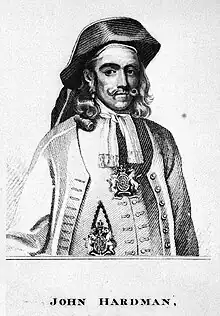John Hardman (MP)
John Hardman (c.1694 – 6 December 1755) was an English merchant and slave trader from Lancashire, England, who was elected as Member of Parliament (MP) for Liverpool in 1754. He and his brother were the owners of Allerton Hall during the 17th century and are believed to have been involved in 46 slave voyages from 1729 to 1761.[1][2]

Biography
John Hardman was the son of Richard Hardman, merchant, of the manor of Rochdale, by his wife Elizabeth Fernyside.[3] His brother, James Hardman (c.1692–1746) was also a slave trader and married to Jane Leigh (painted by Joseph Wright of Derby).[4] The Hardmans were an old Lancastrian landed gentry family.[5]
While some contemporaries described Hardman as a mere 'West India merchant',[6] he was known to have become engaged in the transatlantic slave trade by c. 1729. Indeed, the Hardman family were involved in 46 slave voyages from 1729 to 1761.[1][2] A slave ship-owner, he was said to have had considerable knowledge of African and American trade.[7]
In 1736, Hardman and his brother James purchased Allerton Hall and rebuilt it in the Palladian style.[6] He inherited the estate following his brother's death in 1746.[8]
Hardman regularly gave evidence to the Board of Trade on behalf of the Liverpool Corporation.[9] He had also organised a survey on behalf of the Liverpool merchants of the possibility of a canal to join the rivers Trent and Mersey.[10] In 1754, he was elected as a member of Parliament (MP) for that constituency, but died the following year on 6 December 1755.[7]
Appearance
According to Dagnall, John Hardman had a striking appearance with "flowing locks of golden hair, curled whiskers, earrings, and curiously cut coat and waistcoat. He paraded the streets in this bizarre attire to attract the attention of prospective customers."[11][12]
Legacy
Following his death, Allerton Hall went into possession of his brother's widow until her death in 1795, after which the estate was purchased by the prominent abolitionist William Roscoe.[4] During the American Civil War, Charles K. Prioleau, a Confederate cotton merchant from Charleston, South Carolina, and his wife—'the 'Belle of Liverpool'—rented Allerton Hall as head of Fraser, Trenholm & Co. merchants, often considered the de facto Confederate embassy in Britain.[13][14]
Hardman Earle, 1st Baronet was named after Hardman. Additionally, Hardman Street, Liverpool is named for the Hardman family of Rochdale and Allerton.[15]
References
- Dresser, Madge; Hann, Andrew (2013). Slavery and the British Country House. English Heritage. p. 52. ISBN 978-1-84802-064-1.
- Clements, Max (21 June 2020). "Stark truth that not just city centre benefited from slavery cash". Liverpool Echo. Retrieved 21 March 2023.
- Burke (1849). A genealogical and heraldic dictionary of the landed gentry of Great Britain and Ireland. Vol. 3. London: Henry Colburn. p. 85.
- "Mrs James Hardman". Lancaster Judges Lodgings Museum. 3 August 2021.
- Fishwick, F.S.A (1890). Notes on the Hardman family.
- "Details of Physical Legacy | Legacies of British Slavery". www.ucl.ac.uk. Retrieved 21 March 2023.
- The History of Parliament: the House of Commons 1754-1790, ed. L. Namier, J. Brooke., 1964
- "Townships: Allerton | British History Online". www.british-history.ac.uk.
- Rawley, James A.; Behrendt, Stephen D. (2005). The Transatlantic Slave Trade: A History. U of Nebraska Press. pp. 172–179. ISBN 978-0-8032-0512-3.
- P. Lead, Agents of Revolution: John and Thomas Gilbert - entrepreneurs (Centre for Local History, Keele 1989), 70.
- Dagnall, 1961
- Caulfield, James (1819). "John Hardman". Portraits, Memoirs, and Characters, of Remarkable Persons, from the Revolution in 1688 to the End of the Reign of George II. London: T. H. Whitely.
- Stewart-Brown, Ronald (1911). A History of the Manor and Township of Allerton, in the County of Lancaster. E. Howell.
- Archives, The National. "The Discovery Service". discovery.nationalarchives.gov.uk. Retrieved 21 March 2023.
- "Liverpool Street Names". www.liverpoolpictorial.co.uk. Archived from the original on 1 August 2001.